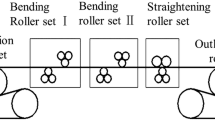Abstract
During the thin strip coiling process, it is necessary to use a sleeve with a mandrel to prevent excessive deformation of the strip. Stress distribution in the sleeve and in the strip is an important factor that determines the quality of the coil. However, owing to the accumulation of high pressure, it is difficult to determine the stress distribution through experimentation. Thus, stress analysis of the strip coiling process was conducted. Finite element analysis was used to investigate the effects of the weight of the strip and the mandrel on the stress distribution and stress concentration near the starting point of the coil. The radial stress was predicted for a coil with a stacked thickness of 384 mm, which corresponds to a strip length of 1486 m, using the stress analysis model developed in a preceding research. A method was presented to reduce the weight and radial stress of a strip coil. It was found that the deformation of the sleeve can be reduced by decreasing the gap between the mandrel segments. The thickness of the sleeve can be reduced from 120 to 106 mm using the stress analysis results. Furthermore, coiling tension can be reduced by 44% compared to the existing value considering the interlayer slip of the strip coil.
















Similar content being viewed by others
References
B. Anderssen, N. Fowkes, R. Hickson, M. McGuinness, in: 26th MISG, BlueScope Steel, Wollongong, 2009, pp. 90–108.
J.S. Lee, K.H. Shin, H.K. Kang, S.S. Park, in: Proceedings of Korean Society for Precision Engineering Autumn Conference, Changwon, Korea, 2010, pp. 257–258.
S.J. Burns, R.R. Meehan, J.C. Lambropoulos, Tappi Journal 82 (1999) No. 7, 159–167.
R.C. Benson, J. Appl. Mech. 62 (1995) 853–859.
N. Zabaras, S. Liu, Acta Mech. 111 (1995) 95–110.
Z. Hakiel, Tappi Journal 70 (1987) No. 5, 113–117.
H.C. Altmann, Tappi Journal 51 (1968) No. 4, 176–179.
X.L. Yu, Q. Yang, Z.Y. Jiang, Key Eng. Mater. 443 (2010) 146–151.
R.B. Sims, J.A. Place, Brit. J. Appl. Phys. 4 (1953) No. 7, 213–216.
J. Case, The strength of materials, 2nd Ed., Edward Arnold & Co., London, 2014.
I. Doghri, Mechanics of deformable solids: linear and nonlinear analytical and computational aspects, Springer e-book, 2000.
S. Yanagi, S. Hattori, Y. Maeda, H. Ibata, Y. Sugimoto, M. Sawada, in: Proc. of the 7th International Conference on Steel Rolling, Chiba, Japan, 1998, pp. 150–155.
S. Yanagi, S. Hattori, Y. Maeda, J. Jpn. Soc. Technol. Plast. 39 (1998) 51–55.
W.W. Park, D.K. Kim, Y.T. Lim, H.C. Kwon, D.K. Choi, M.S. Chun, in: Proceedings of Korean Society for Technology of Plasticity Fall Conference, Gyeongju, Korea, 2012, pp. 273–276.
W.W. Park, D.K. Kim, Y.T. Im, H.C. Kwon, M.S. Chun, Met. Mater. Int. 20 (2014) 719–726.
Y.H. Park, K.T. Park, S.Y. Won, W.K. Hong, H.C. Park, J. Iron Steel Res. Int. 24 (2017) 1–7.
J. Lubliner, Plasticity theory, Dover Publications, INC., New York, 2005.
K.T. Park, Y.H. Park, H.C. Park, S.Y. Won, W.K. Hong, Trans. Korean Soc. Mech. Eng. A 41 (2017) 409–414.
Acknowledgements
This work was supported by the POSCO Research Project (2015Y011) from POSCO Engineering Solution Center, and the Korea Institute for Advancement of Technology (KIAT) grant funded by the Korea Government Ministry of Trade Industry and Energy (MOTIE) (2015 Establishment of GEM, No.H2001-13-1001).
Author information
Authors and Affiliations
Corresponding authors
Rights and permissions
About this article
Cite this article
Park, Kt., Park, Hc. Effects of design parameters and tension on behavior of a coil using finite element analysis. J. Iron Steel Res. Int. 25, 883–891 (2018). https://doi.org/10.1007/s42243-018-0129-9
Received:
Revised:
Accepted:
Published:
Issue Date:
DOI: https://doi.org/10.1007/s42243-018-0129-9



